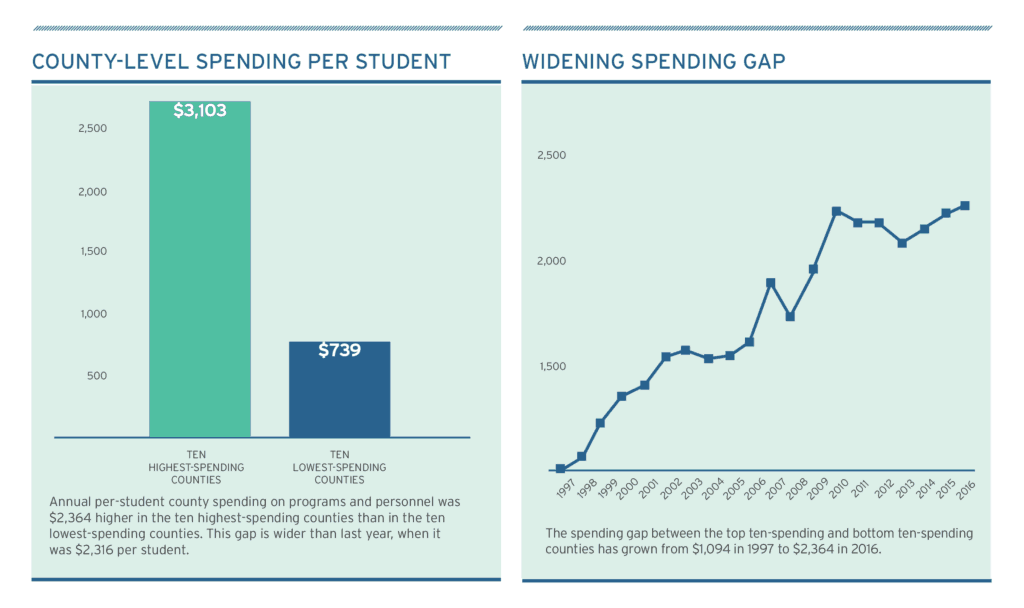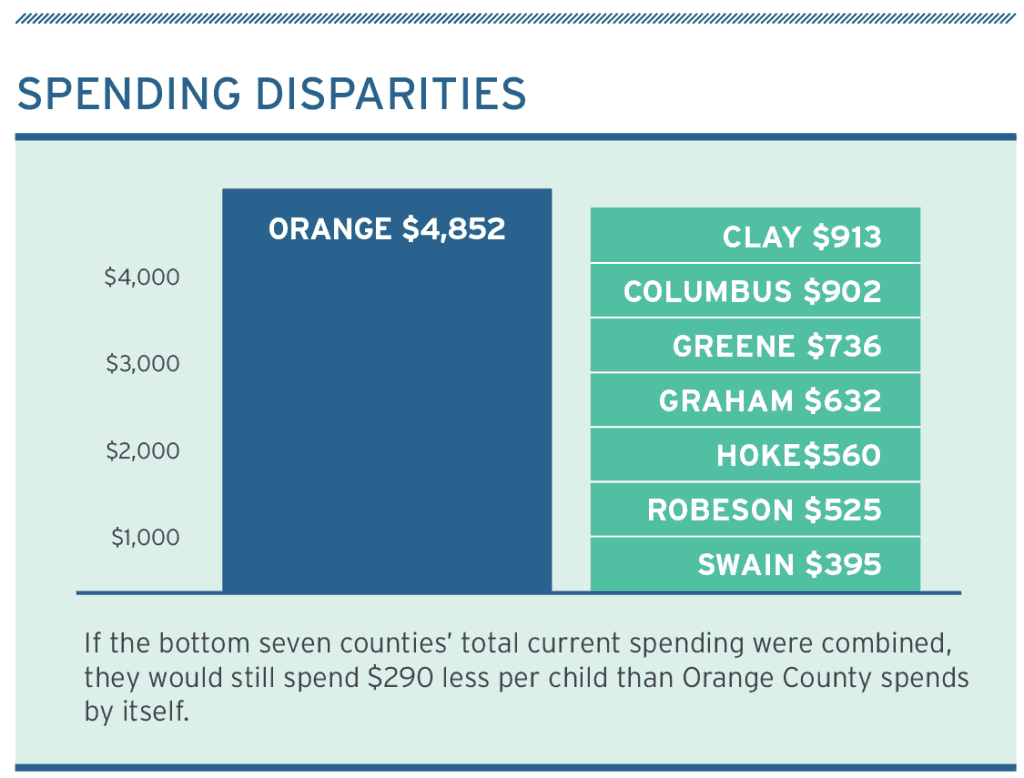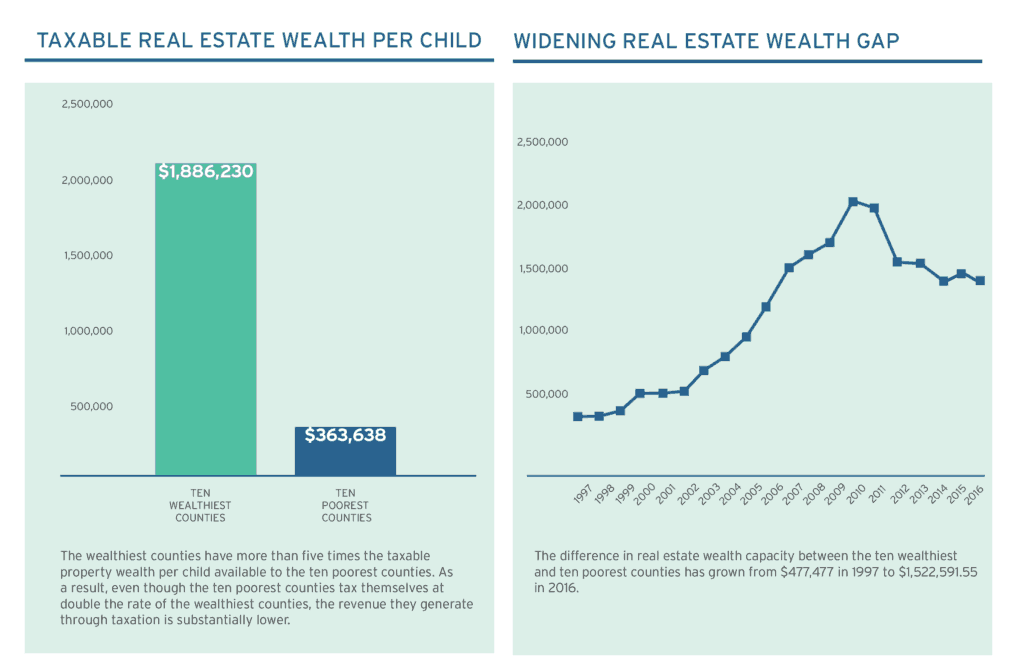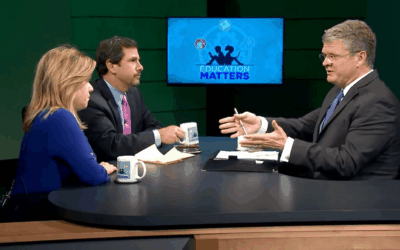

For more than 20 years, the Public School Forum of North Carolina has produced an annual school finance study that examines education funding in North Carolina by isolating local spending from state and federal spending to examine the capacity and actual effort of counties to support public schools. Our 2018 edition confirms what we have seen develop over these last two decades: a chronic and growing gap in public school funding between the highest and lowest-wealth counties in the state.
Policy decisions at the state level have helped by providing additional funds for the state’s smallest and lowest-wealth counties, yet investments in schools still vary dramatically by zip code – and it’s getting worse.
The Numbers
In our 2018 Local School Finance Study, we found that the 10 highest spending counties spent on average $3,103 per student compared to $739 by the ten lowest spending counties, a gap of $2,364 per student. This is based on the most recent county level data available, 2015-2016. The spending gap between the top-10 spending and bottom-10 spending counties has grown from $1,094 in 1997 to the current gap of $2,364 per student. Significantly, this gap has widened every year since 2011 and 18 of the past 20 years.


In 2015-2016, the 10 highest-spending counties spent four times more per child than the 10 lowest-spending counties. Orange County, at the top of the list, spends more than 12 times more per student than Swain County at the bottom. The bottom seven counties combined spend $290 less than Orange County spends on its own. Sixty of NC’s 100 counties are below the state average of $1,596 per student in local support.


These funding disparities have tangible impacts in classrooms. Local salary supplements for educators are generally larger in high-wealth districts, which better positions them to attract and retain top talent. In low-wealth districts that have fewer resources, class offerings often lack the diversity of those found in wealthier ones. And basic classroom supplies such as paper, pencils and textbooks are difficult to come by in low-wealth districts, while their wealthier counterparts are able to tap deeper wallets as they cope with decreased state-level investments.
The bottom line: Our poorest counties continue to fall further behind our wealthier counties in terms of resources available to their local schools. Young people born into one of the state’s economically thriving counties, typically the more urban centers, have levels of investment in their education not shared elsewhere in the state, especially our rural counties.
Why is there a funding gap?
It all comes down to property values. North Carolina’s wealthiest counties are able to invest much more in their local schools because they have a much higher property value base to generate revenue. The wide and growing gap is certainly not because of a lack of effort by county governments.
In 2015-2016, the ten poorest counties taxed themselves at nearly double the rate of the ten wealthiest counties – $0.83 compared to $0.43, a 40-cent difference. Because of the disparities in real estate wealth, however, the revenue that the poorest counties could generate—even at their higher tax rates—was substantially lower than what the wealthier counties could generate.


The time is ripe for a state solution
We’re releasing the 2018 Local School Finance Study at a time of intense focus on how public schools are funded in North Carolina, including a new General Assembly Joint Legislative Task Force on Education Finance Reform, the Governor’s Commission on Access to Sound Basic Education, the My Future NC Commission and a pending court ruling in the 20+ year old Leandro case.
As the General Assembly considers options to overhaul the state’s school finance system, we encourage our legislators to ensure that adequacy and equity in school finance are top priorities. A new funding system alone that does not address adequacy and equity will not bridge the urban and rural divide.
As North Carolina embarks upon reforming the state’s school finance structures and methods, the Public School Forum believes the state should keep these principles in mind:
- Ensure both the adequacy and equity of statewide public school funding. With the long-recognized and now chronic urban v. rural divide in North Carolina that either creates or squelches a school child’s opportunities based solely on zip code, any change to the public school funding formula should be used to help solve this problem.
- Do no harm. At minimum, state leaders should review the funding fundamentals of our state’s public school system and guarantee no harm. This can be accomplished through a pragmatic approach to studying our current system of funding and recommending and testing improvements. If an informed, methodical tack is not taken, this reform could reap an avalanche of unintended consequences that hurt students and their academic performance. A three-year hold harmless provision will aid any transition and create a safety net.
- Build school funding pillars that improve education outcomes for all children. If a fundamental tenet among state leaders is to personalize learning for every child or otherwise guarantee the opportunity for a sound basic education for every child, then funding formulas can be developed to meet these goals. State leaders merely need to decide their priorities in this reform effort and then have the school finance experts build funding formulas to fulfill them.
- NC funding structure presents opportunity for major impact. North Carolina is uniquely situated when it comes to school finance because it is one of the few states where schools are majority state-funded. Under the state constitution and the post-Depression School Machinery Acts, among other laws, it is the state’s responsibility to adequately fund public schools. It is this unique North Carolina history and law that allow school finance reform at the state level to be a real game changer in each school child’s opportunities, regardless of zip code.
Infrastructure needs
Any discussion of support for public education must include infrastructure costs. Under North Carolina’s state constitution and school finance laws, it is the state’s responsibility to pay for instructional expenses (including personnel) while county governments generally pay for capital expenses (buildings and maintenance) unless there are statewide bond referendums or other state solutions. Today, 98 percent of capital expenses are funded at the local level.
However, consistent with the urban v. rural divide, a poorer county in today’s North Carolina cannot generate the revenue necessary for these capital expenses for school buildings and maintenance. At the same time, urban and suburban school districts are dealing with increasing student populations. The NC Department of Public Instruction estimates the current statewide need at $8 billion for public school buildings over the next few years.
Historically, the state has passed a bond referendum every 10 years for school capital construction. The last such statewide bond was in 1996, 22 years ago. Both the House and Senate have introduced companion bills with bipartisan support to put a bond referendum on the 2018 ballot, HB 866/SB 542 Public School Building Bond Act of 2017. These identical bills are eligible in the General Assembly’s 2018 short session in May and should be passed.
Conclusion
We have a unique and historic opportunity before us, but it is not without risk. Public education spending accounts for nearly 40 percent of the state budget. Any major overhaul must be done carefully. Our students cannot afford unintended consequences that could result from a rushed process. Our students also cannot afford to wait. Absent thoughtful changes, we will continue down this path of haves and have nots that is not only wrong, it is unsustainable if we want North Carolina to continue to grow and prosper and truly provide opportunity for every North Carolinian.
Read the full report:


